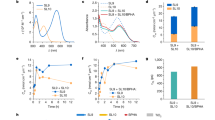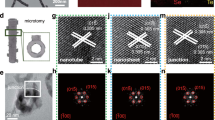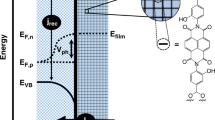Abstract
ONLY TiO2,1 SnO2,2 and SrTiO3,3,4 which do not undergo decomposition upon irradiation when used as photo-electrodes in aqueous media, are stable enough to be used as practical solar energy conversion and hydrogen production devices. The band gaps of these n-type semiconductors correspond to the energy of photons in the ultraviolet region. Solar energy reaching the Earth's surface has, however, a spectrum distribution in the longer wavelength range and cannot, therefore, be used effectively by these semiconductors5,6. Spectral sensitisation would solve this problem by extending the sensitivity of the electrochemical photocells to longer wavelengths. In applying this technique to a real photocell another problem may arise in that most of the solar energy is absorbed by the dye molecules in the solution rather than by the dye molecules adsorbed at the electrode–solution interface, though only the excited adsorbed dye molecules can contribute to sensitisation7–9. To cope with this we have developed a new type of photocell10. In this, the chemically modified SnO2 or TiO2 electrode, with rhodamine B as a sensitiser, was in contact with the transparent electrolyte solution containing a reducing agent as a supersensitiser. In this communication, further developments of this subject are described, especially, the correlation between the efficiency of sensitisation and the structure of the modified layer, which gives us the criteria for more successful chemical modifications of electrode surfaces.
This is a preview of subscription content, access via your institution
Access options
Subscribe to this journal
Receive 51 print issues and online access
$199.00 per year
only $3.90 per issue
Buy this article
- Purchase on Springer Link
- Instant access to full article PDF
Prices may be subject to local taxes which are calculated during checkout
Similar content being viewed by others
References
Fujishima, A. & Honda, K. Nature 238, 37–38 (1972).
Wrighton, M. S., Morse, D. L., Ellis, A. B., Ginley, D. S. & Abrahamson, H. B. J. Am. Chem. Soc. 98, 44–48 (1976).
Watanabe, T., Fujishima, A. & Honda, K. Bull. Chem. Soc. Japan 49, 355–358 (1976).
Wrighton, M. S., Ellis, A. B., Wolczanski, P. T., Morse, D. L., Abrahamson, H. B. & Ginley, D. S. J. Am. Chem. Soc. 98, 2774–2779 (1976).
Gerischer, H. J. electroanal. Chem. 58, 263–274 (1975).
Archer, M. D. J. appl. Electrochem. 5, 17–38 (1975).
Gerischer, H. Photochem. Photobiol. 16, 243–260 (1972).
Memming, R. Photochem. Photobiol. 16, 325–333 (1972).
Fujishima, A., Watanabe, T., Tatsuoki, O. & Honda, K. Chem. Lett. 13–18 (1975).
Osa, T. & Fujihira, M. Nature 264, 349–350 (1976).
Kurzer, F. & Douraghi-Zadeh, K. Chem. Rev. 67, 107–152 (1967).
Fujihira, M., Matsue, T. & Osa, T. Chem. Lett. 875–880 (1976).
Lane, R. F. & Hubbard, A. T. J. phys. Chem. 77, 1401–1410 (1973).
Sprintschnik, G., Sprintschnik, H. W., Kirsch, P. P. & Whitten, D. G. J. Am. Chem. Soc. 98, 2337–2338 (1976).
Toyoshima, Y., Morino, M., Motoki, H. & Sukigara, M. Nature 265, 187–189 (1977).
Author information
Authors and Affiliations
Rights and permissions
About this article
Cite this article
FUJIHIRA, M., OHISHI, N. & OSA, T. Photocell using covalently-bound dyes on semiconductor surfaces. Nature 268, 226–228 (1977). https://doi.org/10.1038/268226a0
Received:
Accepted:
Issue Date:
DOI: https://doi.org/10.1038/268226a0
This article is cited by
-
Chemically modifying electrodes—a classical tool box
Journal of Solid State Electrochemistry (2024)
-
Quantum dot photoelectrochemical solar cells based on TiO2-SrTiO3 heterostructure nanotube array scaffolds
Frontiers of Optoelectronics in China (2011)
-
Effect of different metal ions in a new kind of functionalized self-assembled films of trinary complexes on its photoinduced electron transfer property
Science in China Series B: Chemistry (2000)
-
Advances in dye-sensitized solar cell
Chinese Science Bulletin (1997)
-
Chemical modification of a titanium (IV) oxide electrode to give stable dye sensitisation without a supersensitiser
Nature (1979)
Comments
By submitting a comment you agree to abide by our Terms and Community Guidelines. If you find something abusive or that does not comply with our terms or guidelines please flag it as inappropriate.



